The visionary winged-horse comes down to land as a sure-footed goat. As a cardinal earth sign, Capricorn initiates practical action to make the dreams of Sagittarius real. Through self-mastery, it embodies the instinctual wisdom of the earth and builds structures that stand the test of time.
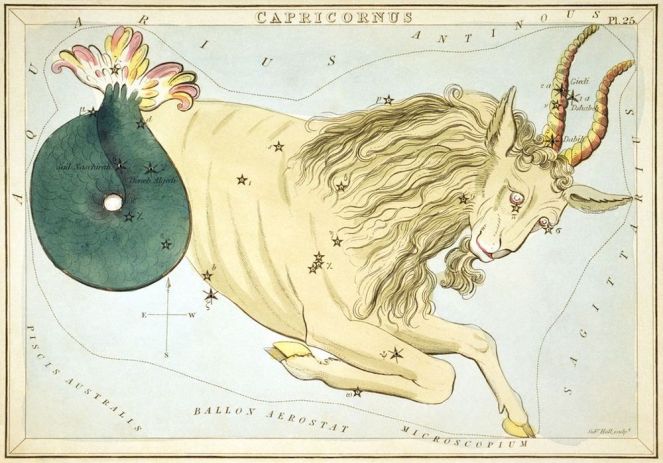
Capricorn is a feminine sign and ruled by Saturn, and is balanced and complemented by the opposite sign of Cancer, ruled by the Moon. Capricorn means ‘goat horn’ or horned goat, and is represented by goats in general as well as the mythical Goat-fish or Sea-goat, which creates an interesting paradox.
It’s an earth sign represented by a creature that comes from the sea, and a feminine sign ruled by the ancient patriarch, Saturn. What’s going on here? In simple terms, the sea-goat links Capricorn to its feminine source in the waters of Cancer, but there’s more to it than that.
Capricorn is the Gate of the Gods where souls ascend after death. It’s an ancient sign with connections to the laws of time and the renewal of life at midwinter. This is the time of year when the sun is at its weakest in the northern hemisphere. At the winter solstice, the sun rises to its lowest point in the sky and stands still for three days (if you go far enough north, it disappears altogether) which symbolises death. Then after midwinter, the sun is reborn from the darkness, symbolising rebirth and the renewal of life.
What does this have to do with goats and/or sea-goats? Let’s find out…
Capricorn Myths – Goats
Goats were one of the first animals to be domesticated about 10,000 years ago. The main ancestor is thought to be the wild Bezoar ibex which lived in the area of the Zagros Mountains in Iran, Iraq and Turkey. But wild goats of various species are found around the world and frequently turn up in ancient art works.
Some of the oldest cave paintings were found at Chauvet in France dating to c. 32,000 BCE. We’ve already seen the lions and the horses that feature prominently in the cave, but alongside a multitude of other creatures you also find the occasional ibex:
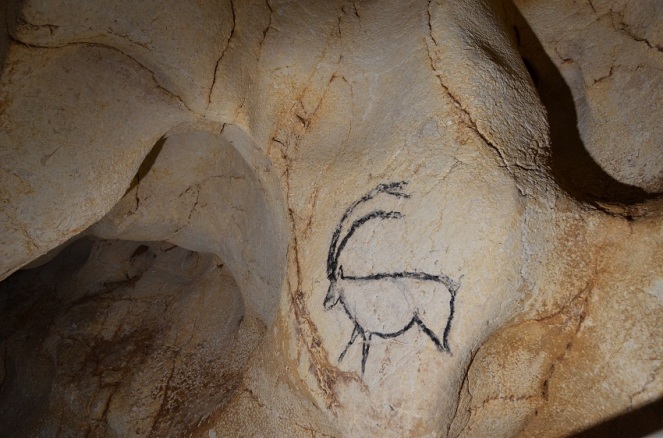
In Iran, there are hundreds of examples of rock art, or petroglyphs, dating back 40,000 years. Almost 90% of the sites feature representations of the ibex. The dates vary: some are more recent at 4,000 years old, but there’s evidence that the ibex was hunted in the region c. 8,000 BCE and probably earlier.
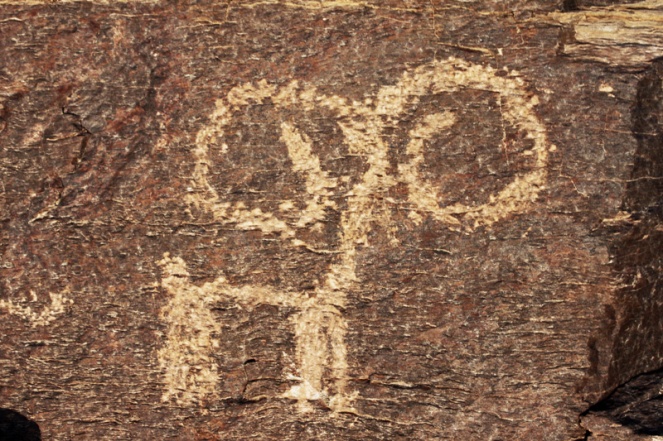
The Mesopotamian cultures that fed into the growth of Sumer produced huge amounts of pottery adorned with ibexes and goats. The creatures are often shown with plants or a Tree of Life, as well as celestial images like stars and suns. Some of the earliest pottery appeared in places like Hassuna, such as this bowl which dates to about 5,500 BCE:
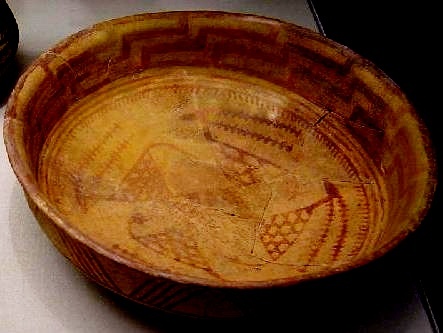
The ibexes here are arranged in a circle around a turning axis and represent an early example of the swastika. The bowl was found containing the bones of a newborn baby which suggests the symbolism was connected with ideas of death and rebirth. The central axis is an abstract representation of the World Tree or World Mountain, the connection between heaven and earth and the axis along which the soul travels after death.
Images of goats and ibexes with trees were connected to the ancient goddess cults of the Neolithic and were symbols of fertility and rebirth. Their curved horns resemble the crescent moon and so were linked to the waxing and waning of the natural cycles of life and death. Here’s an example from a bowl found in a grave in Burnt City in Iran dated c. 3,200 BCE:

The goat here may represent the mother goddess Murkum who was worshipped in the Haramosh valley in Pakistan, which had ties to Burnt City via the Indus valley culture. This bowl is particularly interesting because it might be the first animation ever created. The panels show a Persian desert ibex leaping to eat the leaves of a tree in a series that runs around the bowl like a static flip book. Here it is brought to life:
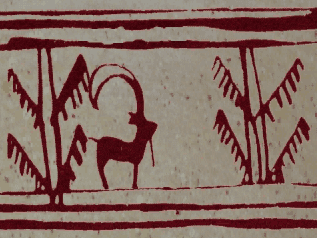
Goats also feature in Sumerian mythology and it’s here that we first encounter the mysterious image of the sea-goat. In Babylonian astrology Capricorn was called Suhur-Maš-Ku, which means ‘the crested goat-fish.’ Gavin White connects the roots of this image to earlier constellations the Stag and the Fish as representations of the sun emerging from the waters of darkness at midwinter.
However, by the 2nd millennium BCE the goat-fish became associated with Enki, god of fresh water, wisdom and magic. He was the twin brother of Ereshkigal (see Scorpio Myths) and the keeper of the gifts of civilisation known as the Me. Enki knew the secrets of life and immortality and created mankind from clay and the blood of the gods. The Babylonians knew Enki as Ea and called him the ‘antelope of the ocean.’
Oannes was the first man Enki created and was one of the Abgal (or Apkallu in Akkadia) who brought civilisation to mankind. The Abgal were primordial beings who were depicted as part man, part fish, or as men dressed as fish. They lived in the ocean and came onto the land to share their wisdom and knowledge, and were often known as the Seven Sages – similar to the Indian version of the myth, the Septarishi.
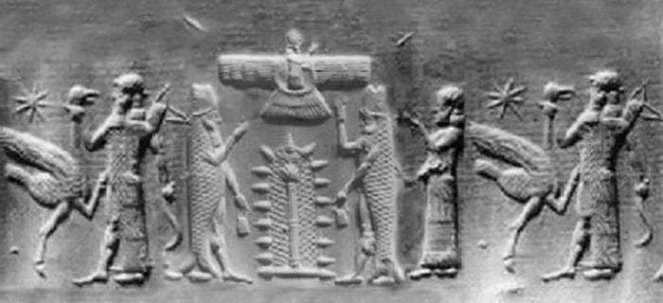
In Egypt, we find another connection between goats, water and the creation of life in the goat-headed god Khnum who was the source of the Nile. Like Enki, Khnum created mankind on his potter’s wheel from clay. Egyptian pharaohs also wore a ceremonial false goat’s beard as a symbol of their divine status, which was often made from actual goat hair.
In Greece, the constellation of Capricorn was identified as Pricus, father of the sea-goats. Pricus was an immortal being created by Kronos. He lived in the sea and ruled over time, but couldn’t control his offspring. The little sea-goats were curious and kept climbing out of the sea onto the land. But once there, they would turn into normal goats and lose their ability to think and speak.
Poor Pricus was beside himself and tried to stop them leaving by turning back time. But each time, the sea-goats would just go back onto the land again, leaving Pricus alone. In the end, he was the only sea-goat would could still think and speak. Obviously, he wasn’t happy about that and felt terribly lonely, so he asked Kronos to let him die. Kronos obliged and put Pricus into the stars.
Another possible candidate for the Capricorn constellation is Amaltheia, the goat who looked after Zeus when he was a child. Zeus was the son of Kronos and Rhea, who were Titans. Kronos discovered that one of his sons would overthrow him, just as he had overthrown his own father, Ouranos. To prevent this from happening, he swallowed his children. But Rhea saved Zeus by tricking Kronos into swallowing a stone instead – Kronos was a bit thick! – and hiding Zeus in a cave with Amaltheia.
Later Zeus returned to castrate Kronos and became King of the Gods. He thanked Amaltheia by placing her among the stars and turned one of her horns into a cornucopia, which means ‘horn of plenty’ – a symbol of abundance and prosperity. But Amaltheia isn’t Capricorn. She was placed in the sky as Capella, the goat star, part of the Auriga constellation, a charioteer holding a goat and two kids.
Our final Capricorn sea-goat candidate comes in the form of Pan, the Greek god of the wild who had the legs and horns of a goat. But there’s another figure called Aegipan who may fit the bill better. Aegipan was often identified with Pan but they were also seen as separate beings. His name means ‘goat-Pan’ and he was fully goat rather than half-man like Pan. In one myth, while the Olympians were battling Typhon, Aegipan helped Zeus by jumping into a river and becoming a goat-fish – a goat turning into a sea-goat, reminiscent of Pricus.
Pan himself has connections to the deep past of Greek mythology. There are so many myths about his parentage that it’s clear he pre-dates the Olympians. In other words, Pan is from the earlier goddess-based fertility cults connected to the earth and nature – and goats. Pan was known for his rampant sexual antics and hung out with fauns and satyrs, playing music on his pipes. He was also a companion to Rhea, the ancient mother goddess.
Capricorn Myths – Midwinter
Midwinter festivals celebrate the rebirth of the sun and the renewal of life and fertility. The rebirth of the sun symbolises immortality and the conquering of death – the light returning after darkness and the hope of spring returning after winter.
Evidence for these festivals can be found way back into the Neolithic. For example, there were huge feasts at Stonehenge where the solstice was celebrated at sunset. At Newgrange in Ireland, the passage and inner chamber light up at sunrise on the solstice. And there are similar alignments at sites like Maeshowe in Orkney and Callanish on the Isle of Lewis.
Midwinter festivals are found in later cultures too. Egypt celebrated the birth of Horus for 12 days at midwinter and the Babylonians had a similar 12 day festival of renewal for Marduk. The Romans had the festival of Saturnalia which involved copious food and drink, gift-giving, and lots of messing about and being silly. And in Scandinavian and Germanic cultures there’s the 12 day festival of Yule which involved the Yule goat. Apparently this has nothing to do with Thor – who used to kill and eat his goats and then bring them back to life with his hammer – but with saving the last sheaf of grain from the harvest, a way to seed life for the new year.
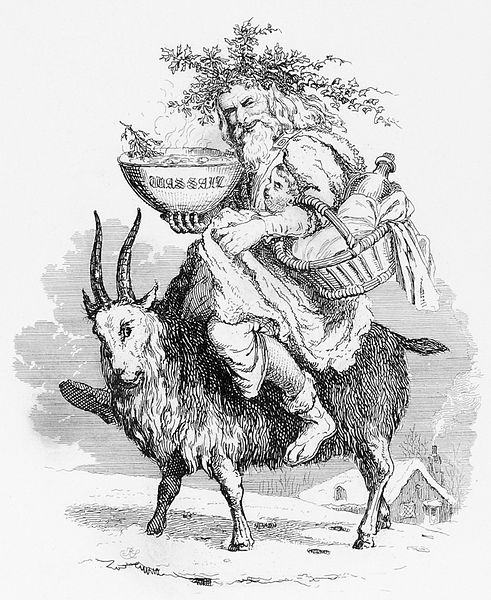
But the really interesting part is how this relates to goats: both the ancient Bezoar ibex and the Alpine ibex have mating seasons that straddle the winter solstice. The ancients would have observed the animals’ behaviour and incorporated it into their myths linking randy goats to the death and rebirth of the sun. It’s no coincidence that the goat is connected to the idea of fertility and the renewal of life in the dark winter months of the year.
Explore further: The Origins of Christmas–Part 1: Pagan Roots and going further back Part 2: Shamanic Roots
The Meaning of Capricorn
Capricorn is a paradoxical sign with rulers and symbols that are also dual in nature. This creates a complex picture but the heart of it involves the relationship between the wildness of instinct and the structure necessary for consciousness and civilisation. Go too far in either direction and you’re in trouble – drowning in unconscious identification with nature, or crushed by a tyrannical ego.
The Capricorn goat symbolises the instincts of lust and fertility, while the sea-goat represents our primordial origins in the oceans of chaos (see Cancer Myths). But as a dual creature, the sea-goat also unites two extremes: the abyss and the heights of the mountain. This represents the Cross of Matter and the tethering of the soul to the body.
Out of the water comes the wisdom and secrets of life, and through effort, they’re given form.
This is a profound subject and a profound sign, much deeper than the usual materialistic descriptions of worldly success and building an empire – although that can be part of Capricorn’s path too. But the highest expression of Capricorn is about spiritualising matter – making the body sacred by willingly entering incarnation and enduring the limitations of being in a body without being ruled by the instincts.
Capricorn combines the fertility of the goat with the restriction of matter as symbolised by Saturn. The sea-goat adds serpent energy (Kundalini) combined with the intelligence of the goat. Put this together and you have the potential for self-mastery. This is similar to Virgo where the serpent energy is turned inwards to transform the self, but in Capricorn it’s turned outwards to transform the world and create civilisation.
Self-mastery means overcoming the instincts without repressing or denying them and transmuting the life force into spiritual wisdom and enlightenment. This provides Capricorn with another symbol: the Bodhisattva, or anyone on the path to awakening and a life of service.
The slow climb up the mountain of enlightenment is really a process of stripping away and aligning the body and soul with the truth that’s already present. It means putting the teachings discovered in Sagittarius into practice and ‘taking up the cross’ or initiation onto the path.
Capricorn shows that the spiritual path and enlightenment aren’t about escaping the world of matter and the body, but about being fully present and incarnate. The path of the bodhisattva means serving humanity from down here in the mud and getting your hands dirty by building something from the ground up. At its best, Capricorn means embodying spiritual truth and living with integrity – in other words, walking your talk.
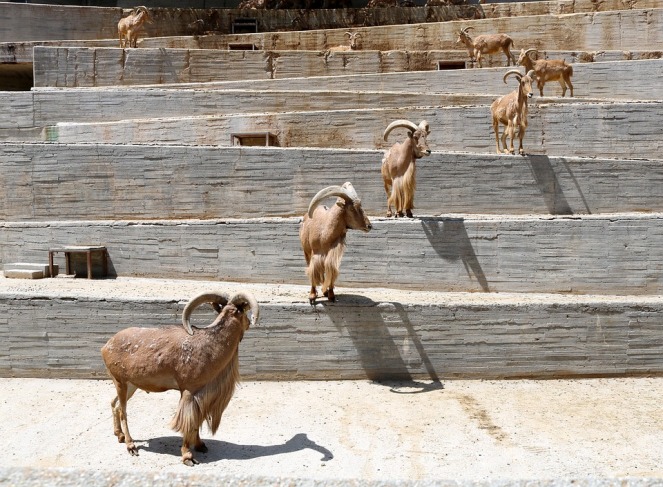
Wisdom comes from engaging with life on its own terms on a practical level. Spiritual truths have to be lived as reality, not just as a noble idea or vision, and this takes time and self-discipline. A vision is no use to anyone if it doesn’t work, and that means grappling with the limitations, boundaries, rules and structure of Saturn.
Like the sea-goat, Saturn has a dual nature. He’s a repressive father figure, the old king who swallowed his children, but also the ancient ruler of the Golden Age, a time of abundance and prosperity celebrated at Saturnalia. Saturn is also linked to the old fertility rites of the goddess through his mother Gaia, and used her sickle to castrate his father, Ouranos. The sickle symbolises the moon and stands for the power of the goddess. So Saturn is his mother’s son and does her bidding using her power – a patriarch who rules by consent of the goddess.
On a good day, Saturn understands that life can only flourish with discipline and effort and time. The problems begin when Saturn thinks the power of life belongs to him. Then his structures become too oppressive and he tries to control nature rather than work with it. This is why the old order must be periodically overthrown so that life can be renewed. The old king has to die so the new king can be born.
This is the natural progression of death and rebirth represented in the myths of midwinter and the turning of the year at solstice. The old king is sacrificed to ensure the fertility of the land, but this symbolism can be applied to any system or structure that no longer supports life.
Capricorn embodies the potential for enlightened leadership and the ability to work with cycles of fate and the natural world. You have to do this if you want to build a civilised society and create structures that will outlive any one individual. It’s about growing up and taking responsibility and working with reality rather than fighting it.
You can’t avoid the limitations of reality. Suffering is part of life and Capricorn knows – or eventually learns – that it’s best to take the lesson and get on with the business of living on reality’s terms – to accept the cross of matter and learn the wisdom that life is teaching you.
This isn’t easy and accepting the cross can feel like a crucifixion or dark night of the soul. You feel cut off from your divine home, but this is a necessary part of the process. The feeling of abandonment can be healed through atonement and the faith to recognise that the divine is present in all things.
But this faith also has to be tested otherwise it’s not real, and that means accepting life as it is. Your cross then becomes an act of service to the community and allows you to build something larger than yourself that will outlast your own life.
Growing up and taking responsibility doesn’t mean you have to be miserable and spend all day working your arse off. Capricorns are notorious for their dry sense of humour which comes from seeing deeply into the absurdity of life and learning some tough lessons about humility. Capricorn gets easier with age (as do Saturn transits if you work with them) and you can loosen up a bit and reconnect with the impish goat. As Liz Greene says in The Astrology of Fate:
“…it is only later in life that the jubilant boy, at last contained by the Father, looks out of the eyes of the middle-aged man, or the young girl, full of the joy of a youth she probably missed in actual youth, smiles from the face of the experienced woman. This faith fought hard for, doubted, lost and found again in darkness is the sustenance of the mature Capricorn, who – man or woman – can then father the next generation with grace.”
And we badly need more enlightened guides in how to live a responsible and joyful life right now.
Capricorn on Film
Films that represent the Capricorn archetype include stories about old age, growing up or coming of age, as well as fathers and authority, discipline, integrity, taking responsibility, and spiritual enlightenment or atonement. You’ll have your own favourites, but here are a few examples of Capricorn on film:
- For a dark father figure who is ultimately redeemed, look no further than Darth Vader in the Star Wars films.
- And for a bona fide Buddha, see the Dalai Lama in Kundun.
- Billy Elliot who achieves his dream of becoming a professional dancer through self-discipline in Billy Elliot.
- The tragic Charles Foster Kane who achieves great success but loses his childhood in Citizen Kane.
- Carl Fredricksen learning to love life again on an adventure with balloons and talking dogs in Up.
- Sacrificial lamb PC Howie who goes up in pagan flames in The Wicker Man.
- Andy Dufresne doing time for a crime he didn’t commit and making the best of a bad situation in The Shawshank Redemption.
- Hedonist Ron Woodroof who finds a way to help fellow AIDS sufferers in Dallas Buyers Club.
- Aging mutant Logan on a quest to help his feral daughter find Eden in Logan. (read post)
More on the violent world of Logan here. Next month we’ll look at Aquarius Myths
More on Midwinter Festivals here: The Origins of Christmas – Part 1: Pagan Roots and Part 2: Shamanic Roots
Discover more Zodiac Myths here
More on Capricorn:
- Capricorn Keywords
- Capricorn Traditional Correspondences
- The Story Behind Saturn
- Saturn in Capricorn
Images: Capricorn; Oannes; Yule Goat
Thanks for reading! To support my work, donate below 🍵. Thanks in advance! 🙏❤️

